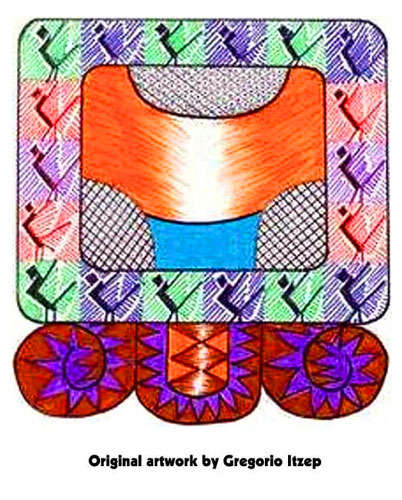
K’at Trecena
by Kenneth Johnson
The word “kan” literally means “yellow” in Yucatec Maya. The same day sign is called “k’at” in the K’iche’ language, which means a net bag. To the Aztecs, this day-sign was a lizard. What do all these symbols have in common?
This day sign represents fertility and the power of growth. The association between the lizard and the power of fertility runs strong and deep in many Native American societies. The Pueblo peoples of the American Southwest, whose culture is deeply linked with ancient Mexico, regard the lizard as a symbol of growth, sexuality, and the life-giving rain. Lizards, common themes in the rock art of Arizona, New Mexico, and Utah, are typically found in contexts suggesting fertility. The Aztec deity associated with this day-sign was Huehuecoyotl, the “god of the dance.”
The name Huehuecoyotl means “Ancient Coyote,” and herein lies another clue to the meaning of this day-sign. Coyote is a popular figure all over Native America. He is sometimes wise, but more often foolish, and the stories told about him are frequently obscene. Though he steps on his own tail, loses his own rectum, and is typically sent off howling at the end of the story, he is nevertheless reverenced as a wise creature, and sometimes as the creator of the universe itself. Coyote is the Trickster, that wild spirit of untamed nature who is both fiendishly clever and unabashedly sexual.
Both the abundance and sensuality of this day-sign are embodied in the K’iche’ Maya symbolism of this day sign, where it represents a net bag. The Popol Vuh tells the story of a pair of twins born to Xmucane and Xpiyacoc, the primal creative pair, sometimes simply known as First Grandmother and First Grandfather. The twins were challenged to a handball game by the lords of the Underworld. The brothers failed, were sacrificed, and one of them ended up with his skull hanging in a calabash tree in the Underworld. Blood Woman, daughter of one of the lords of the dead, walked by the calabash tree and the skull spit in her hand. This made her pregnant with another pair of hero twins who would brave the Underworld themselves and become the protagonists of the next divine handball. Fearful of retribution from the lords of the Underworld, Blood Woman escaped to the upper world and made her way to the home of First Grandmother Xmucane. When she told First Grandmother that she was pregnant with the Old Wisdom Crone’s grandchildren, Xmucane was not inclined to believe her. She gave her a net and told her to go and gather corn. Blood Woman found only a single clump of corn growing in the field to which she was sent, but her magic was so strong that the cornsilk from a single ear of corn grew into many, many ears of corn, filling the net. Knowing that her sons, the first pair of Hero Twins, were also the planet Venus, and knowing that Venus would return from the Underworld on a day called K’at (“net” in K’iche’), First Grandmother realized that Blood Woman was telling the truth. A new pair of Hero Twins would soon be born.
The day-sign Kan is also one of the days which carries within it the sacred energy inherent in fire. This is not the “sacred fire” which plays such a powerful role in the Mayan Fire Ceremony. Rather, Kan represents the quieter fire of the family hearth, the fire in which we cook our food. This, too, is part of the symbolism of Kan as a day-sign of abundance, prosperity, earthly wisdom and earthly growth. Fire is the purest of all the elements. Unlike air, water, and earth, which can all be polluted by the unconscionable actions of humankind, fire is always pure. The simple fire of hearth and home may play just as much of a role in purifying our lives and burning away the contents of our karmic net as does the more sacred fire of ritual.
At this time, we express our intention always to have understanding. It is a favorable time to pray for abundance, as well as for the safety and well-being of all those who are incarcerated in prisons and jails. Kan is a day in which that which was all tangled up as if in a net may at last become untangled. It is also a day upon which healing ceremonies and practices are sometimes performed, especially if the necessary healing is psychological in nature.
http://www.jaguarwisdom.org

